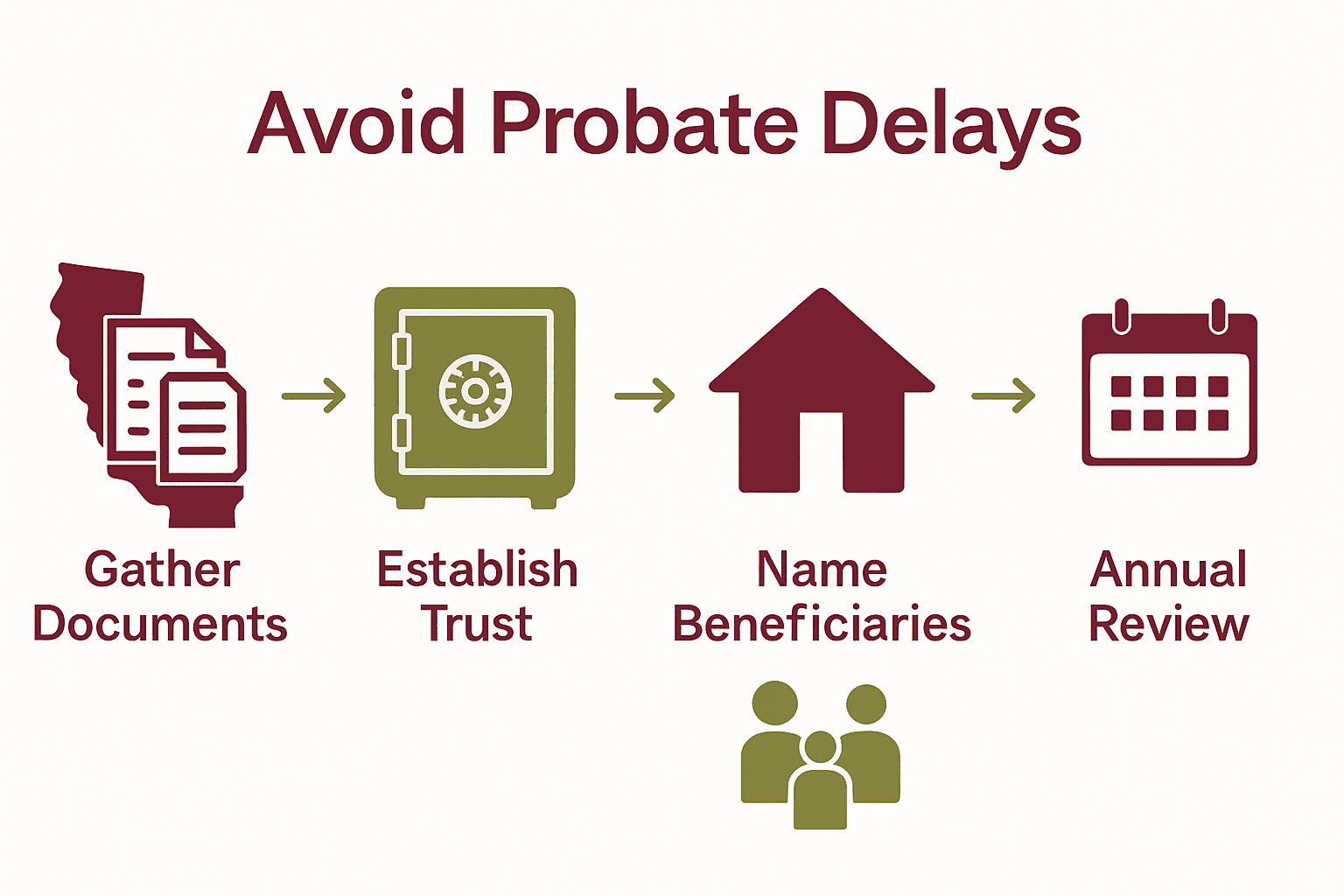
PARENTS & HOMEOWNERS: MY 7-STEP ESTATE PLANNING PROCESS WILL PROTECT YOUR HEIRS
From Creditors, Predators & Bad Choices, And Will Help You Become a (Bigger) Hero to Your Family!



Avoiding Probate Delays: Steps for California Families
Did you know that probate delays can stretch over a year in some states, causing both financial strain and emotional stress for families? Taking charge of your estate planning now helps your loved ones avoid court battles and confusing paperwork. With a clear plan, you gain peace of mind knowing your wishes are honored and your assets are protected from unnecessary complications.
Quick Summary
| Key Point | Explanation |
|---|---|
| 1. Gather essential estate documents | Collect original signed documents to prevent probate delays and family stress during estate planning. |
| 2. Establish a living trust | Create a revocable living trust to protect assets from probate and maintain privacy for your family. |
| 3. Name beneficiaries accurately | Designate primary and contingent beneficiaries to ensure prompt asset transfer without legal complications. |
| 4. Choose trusted executors and guardians | Select responsible individuals to manage your estate and care for your children, ensuring your wishes are upheld. |
| 5. Regularly review your estate plan | Update your estate documents after major life events to avoid probate issues and align with current circumstances. |
Table of Contents
- Step 1: Gather Essential Estate Documents
- Step 2: Establish a Living Trust for Key Assets
- Step 3: Name Beneficiaries and Update Titles
- Step 4: Appoint Trusted Executors and Guardians
- Step 5: Review and Verify Your Estate Plan Regularly
Step 1: Gather Essential Estate Documents
Saving your family from potential probate nightmares starts with collecting and organizing critical legal documents. This step helps ensure your estate plan moves smoothly and prevents unnecessary court delays and family stress.
Begin by creating a comprehensive document collection that covers every aspect of your financial and legal life. According to estate planning experts, you will want to gather original signed documents that include your trust instruments, will, durable powers of attorney, and healthcare directives.
Start with these key documents:
Here’s a summary of essential estate documents and their purposes:
| Document Type | Purpose | Typical Contents |
|---|---|---|
| Will | Distributes assets Names guardians |
Beneficiaries Executor choice Guardianship info |
| Trust Documents | Avoids probate Controls asset management |
Trust instructions Beneficiaries Trustee assignment |
| Durable Power of Attorney | Manages finances if incapacitated | Agent designation Financial powers |
| Advanced Healthcare Directive | Guides medical decisions | Healthcare agent Treatment preferences |
| Life Insurance Policies | Provides financial support | Policy details Beneficiary listing |
| Property Deeds | Proves real estate ownership | Title info Transfer history |
| Account Statements | Documents retirement assets | Account numbers Beneficiaries |
| Marriage/Birth Certificates | Confirms family status | Legal relationship info |
- Original will with original signatures
- Trust documents (revocable living trust, irrevocable trusts)
- Durable power of attorney for financial decisions
- Advanced healthcare directive
- Life insurance policies
- Retirement account statements
- Property deeds
- Vehicle titles
- Marriage certificate
- Birth certificates
Store these documents in a fireproof and waterproof safe or safety deposit box. Critically important: inform your designated estate executor or trustee about the exact location of these documents.
 According to research from estate planning guidelines, ensuring agents know document locations can prevent potential court delays and conservatorship complications.
According to research from estate planning guidelines, ensuring agents know document locations can prevent potential court delays and conservatorship complications.
Pro Tip: Create digital copies of all documents and store them securely in an encrypted cloud service as a backup.
In the next step, you will review these documents with a qualified estate planning attorney who can help you confirm everything is current and legally sound.
Step 2: Establish a Living Trust for Key Assets
A living trust is your strategic shield against probate court delays and financial complications. By transferring your key assets into a revocable living trust, you create a powerful legal mechanism that protects your family’s financial future and preserves your estate’s privacy.
To begin establishing your living trust, identify your most valuable assets that you want to protect. According to research from how a revocable living trust can protect your assets, this typically includes your primary residence, vacation properties, investment accounts, and significant personal property.
Key steps for creating your living trust:
- Consult with an estate planning attorney
- Inventory all significant assets
- Determine trust beneficiaries
- Draft the trust document
- Legally transfer asset titles into the trust
- Select a reliable trustee
Research from Los Angeles real estate studies highlights a critical benefit: placing your home in a trust can avoid probate court delays that often stretch 9 to 18 months in metropolitan areas.
These delays can create significant financial strain and emotional stress for your family.
Pro Tip: Ensure you transfer all asset titles completely into the trust to maximize protection and avoid partial probate scenarios.
In the next step, you will finalize trust documentation and begin the critical process of asset transfer with professional legal guidance.
Step 3: Name Beneficiaries and Update Titles
Preventing probate delays means strategically naming beneficiaries and updating asset titles to ensure smooth, rapid transfer of your estate. This critical step can save your family months of legal complications and financial uncertainty.
According to research from Kiplinger, beneficiary designations on accounts like life insurance, IRAs, and 401(k)s actually override your will or trust documents. This means carefully selecting both primary and contingent beneficiaries becomes crucial for seamless asset transfer.
Multiple asset types in California can bypass probate when properly designated:
- Retirement accounts
- Life insurance policies
- Payable on death (POD) bank accounts
- Transfer on death (TOD) securities
- Vehicle titles with TOD provisions
- Real estate deeds with transfer mechanisms
- Joint tenancy properties
Work closely with your estate planning attorney to review each asset class. When naming beneficiaries, be specific and include full legal names. Consider naming contingent beneficiaries as a backup in case your primary beneficiary cannot inherit.
If you update your estate documents regularly, you can prevent potential conflicts and ensure your wishes are accurately reflected. Major life events like marriages, divorces, births, or deaths should trigger an immediate review of your beneficiary designations.
Pro Tip: Review beneficiary designations annually and after significant life changes to maintain accuracy.
In the next step, you will organize these updated documents and prepare for a comprehensive estate planning review with your attorney.
Step 4: Appoint Trusted Executors and Guardians
Selecting the right executors and guardians is your final shield against potential probate complications and family conflicts. This crucial step ensures your wishes are respected and your loved ones are protected during challenging times.
Research from estate planning experts recommends using durable powers of attorney and advance health care directives to name trusted agents who can make critical financial and medical decisions on your behalf. These legal documents prevent court-appointed conservatorships and minimize potential administrative delays.
When choosing your executor and guardians, consider these key factors:
- Emotional stability
- Financial responsibility
- Alignment with your family values
- Geographic proximity
- Age and health
- Willingness to serve
For guardianship, parents should carefully consider the legal implications of naming a guardian who can provide emotional support and financial stability for your children. Your chosen guardian should understand your parenting philosophy and be willing to raise your children as you would.
For your executor, select someone who is organized, trustworthy, and capable of managing complex financial transactions. This person will be responsible for settling your estate, paying debts, and distributing assets according to your wishes.
Pro Tip: Always discuss your intentions with potential executors and guardians beforehand to ensure their willingness and preparedness.
In the next step, you will document these appointments formally and ensure all legal paperwork accurately reflects your chosen representatives.
Step 5: Review and Verify Your Estate Plan Regularly
Your estate plan is not a one-time document but a living strategy that demands regular attention and updates. Think of it like maintaining a high-performance vehicle your financial future depends on consistent care and precision.
Research from estate planning experts highlights the critical need to review your estate documents after major life events or significant legal changes. Failing to update your plan can trigger unexpected probate complications, create tax burdens, and potentially leave your family vulnerable.
Key moments that demand an estate plan review:
- Marriage or divorce
- Birth of children or grandchildren
- Significant changes in financial status
- Purchase of new property
- Inheritance or major asset acquisition
- Changes in tax laws
- Relocation to a different state
Even with a carefully crafted trust and pour-over will, the importance of regularly reviewing your estate plan cannot be overstated. Failing to fund your trust or coordinate beneficiary designations can inadvertently push your estate into probate court.
Set a calendar reminder to review your estate documents with your attorney annually. During these reviews, verify that all asset titles are correctly designated, beneficiary information is current, and your plan reflects your latest family and financial circumstances.
Pro Tip: Treat your estate plan like a living document. Small, proactive updates can prevent massive legal headaches for your family later.

In the final step, you will compile all your updated documents and ensure your executor and trusted advisors have current copies of your comprehensive estate plan.
Secure Your Legacy and Bypass California Probate Delays
Is the fear of probate delays, court headaches, and family stress keeping you up at night? You deserve peace of mind. The steps you just learned—gathering original estate documents, creating a living trust, updating beneficiaries, and appointing trusted executors—are powerful strategies. But navigating California’s complex estate laws on your own can quickly become overwhelming and lead to the very delays you want to avoid.
For tailored support, connect with the trusted attorneys at the Law Office of Eric Ridley | Estate Planning | Wills & Trusts. Our team is dedicated to helping California families with estate planning, trust creation, probate administration, and more. Let us be your guide so your plans are solid, documents current, and your family’s future protected.

Ready to protect your assets and keep your loved ones out of probate court? Act now by visiting our main site at https://ridleylawoffices.com and scheduling your confidential consultation. Take control of your legacy today and experience the confidence that comes from having the right legal partner at your side.
Frequently Asked Questions
What are the essential estate documents I need to gather to avoid probate delays?
To avoid probate delays, you need to collect key estate documents like your will, trust documents, durable power of attorney, and healthcare directives. Start by creating a comprehensive collection, including originals and vital records, and store them in a secure place.
How can establishing a living trust help my family avoid probate?
Establishing a living trust transfers your key assets into a protective legal structure, thereby bypassing probate. Consult an estate planning attorney to ensure your most valuable assets, such as your home and investment accounts, are included in the trust within 30 days of creation.
What does it mean to name beneficiaries on my accounts, and how does this help with probate?
Naming beneficiaries ensures that your assets, like life insurance and retirement accounts, pass directly to your chosen individuals without going through probate. Regularly review and update these designations, especially after major life events, to maintain accuracy and prevent delays.
How do I select the right executor and guardian for my estate plan?
When choosing an executor and guardian, consider factors like their emotional stability, financial responsibility, and willingness to serve. Create a list of potential candidates and discuss your intentions with them to ensure readiness and alignment with your wishes.
How often should I review my estate plan to prevent probate complications?
You should review your estate plan at least annually and after significant life changes, such as marriage or the birth of a child. Regular updates help ensure that your wishes are reflected in your plan and can reduce probate complications significantly.
What specific steps can I take to prepare my estate plan for potential changes in tax laws?
To prepare your estate plan for potential tax law changes, regularly meet with your estate planning attorney to discuss possible updates or strategies. Consider documenting your assets and beneficiary designations annually to stay current and adjust your plan as necessary.
Recommended
- Avoiding Probate in California: Strategies for Families in 2025 – Law Office of Eric Ridley
- How Probate Works in California: What Families Need to Know in 2025 – Law Office of Eric Ridley
- Understanding Probate Process in California: 2025 Guide for Families and Homeowners – Law Office of Eric Ridley
- California Probate Process Explained: 2025 Guide for Families and Homeowners – Law Office of Eric Ridley
